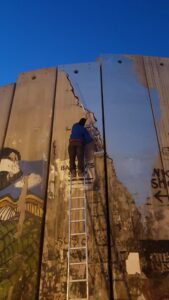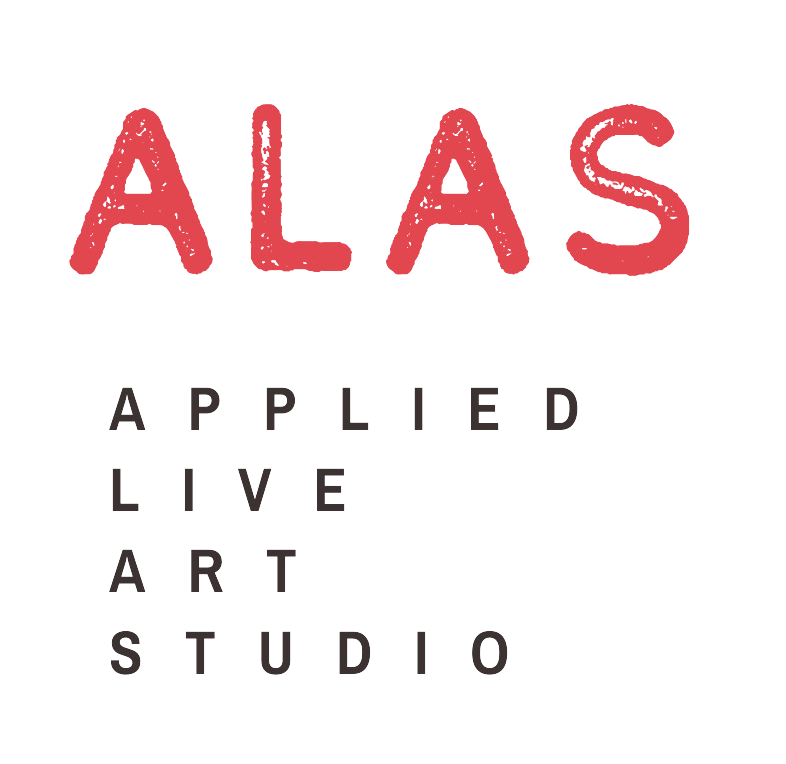Blog 5: Peering through the Crack: Art as Resistance and Resilience
29.04.25
Alisha Waters –
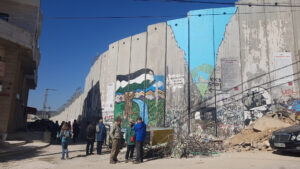
In the early part of April, I had the opportunity to interview a creative collaborator of ALAS, Salah Abu Laban, Palestine tour guide and owner of Backpackers Hotel, Bethlehem. Salah was instrumental in creating the Rachel’s Tomb mural in Bethlehem, 2017.
‘Rachel’s Tomb’ is an ancient holy site for multiple faiths. It is a site of religious importance, located in the Palestinian city of Bethlehem, and under Israeli Military control behind the separation wall in the below photograph. In 2017, during a walking tour led by Salah, ALAS director R.M. Sánchez-Camus asked ‘who paints all this graffiti’ (on the separation wall), and Salah responded ‘tourists’ with a shrug. When asked what Palestinians would like to actually see on the walls, he replied ‘no one has ever asked us’. This became a moment of planning, over tea and conversations with others, it was agreed that what locals wanted most was to see the Ottoman-era Mosque on Rachel’s Tomb, that had been left behind the wall that went up after the Aqsa Intifada in 2000.
Tear gas and disturbance – that was the experience of painting the mural, perched on top of an extension ladder placed on top of a metal metal rubbish container for more height. Salah warned never to peer over the edge as the walls are controlled by automatic sniper guns. Shortly after this art intervention, unbeknownst to everyone, the Banksy ‘Walled Off Hotel’ opened. This brought international media attention that continues to highlight the conflict and need for a long-term resolution that supports all peoples.
Below comes the interview from the 9th April 2025. I asked Salah about his memories and role in the mural, his opinions on art serving as a tool that can aid peace-making processes, psychogeography, and the importance of travelling. This became a profound conversation on freedom, history, humanisation, and empathy.
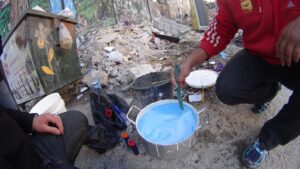
A.W: When Marcelo first came to Palestine, the intention wasn’t to create the mural, rather it happened. What is your memory of the mural, how did you decide on the mural, what was your participation and what was the process like?
S.L: I don’t remember the circumstances specifically, but the idea was created when we walked nearby the wall and he wanted to leave a message, a way of supporting Palestine. I told him that the word of mouth, and people coming and ‘beautifying the wall’ is actually not beautifying the wall but instead surrounding Palestinians with messages of support, positive stories and emotions and trying to suffocate the negativity of the wall with the beauty of the murals. I gave the idea of the mural and what it could be, through the crack in the wall, to allow the Palestinians to see through the wall, to transcend through the wall and that’s why I said if the wall wasn’t here, we would be able to see Rachel’s Tomb. We decided where to put the mural based on the fact that standing there, you could see Rachel’s Tomb. Funnily enough, right in front of the wall a month later, the Banksy Hotel opened, 3 metres from the mural. A month later the picture of the wall where the mural is and the Banksy hotel happened to be picture number one in the world, and was circulated, due to the significant coincidence. I remember when we were making the mural it was pretty risky as we were climbing on the wall one side and 200 metres away were some protests, so we were actually painting, I helped with the idea, and the painting. It was risky as we couldn’t reach up high, the ladder wasn’t high enough. We had to pile one or two street trash cans, flipped them, and had the ladder on top to reach up high on the wall. We were painting and smelling the tear gas from the protest 200 hundred metres away. Making the painting, especially, was a big challenge. They have orders to shoot and kill anyone who comes over the wall. We were careful to do it, and to do it fast while they were busy with the protests, without peaking above.
A.W: Do you think that the arts can play a role in peace-making processes?
S.L: I believe art can create awareness. When art reaches two minds that are interested in creating peace, minds will make peace. Art itself doesn’t make peace, but encourages people to start moving and thinking. Art is the tool itself.
A.W: How can we use creativity to make a change?
S.L: I believe that connecting the world with art that is made in Palestine, connects the story and connects them to the people behind the story. Although the mural isn’t there anymore, as hundreds more people have painted on the wall too, if the same mural, and the same pictures are being shown worldwide, this could create more knowledge and allow it to reach more people around the world. To copy the knowledge, the experience, and to show it to the world, allows creativity to make a change.
A.W: I hear that you are a keen traveller, would you be able to tell us a bit about your view on how important it is that travel can be freely done? How did travel encourage your backpacking hostel business?
S.L: Travel for every person in the world is an essential need. For a Palestinian it is an obsession. Why it is an obsession for a Palestinian is because it is not allowed. Palestinians do not have passports, we have travel documents. That’s why whenever any of us have the chance to travel a couple of hundred kilometres, it is something insane, it would be an experience of a lifetime. That’s why I started working in the travel business, somewhere around 12 years ago. My idea was that I could become able to travel, despite the fact that I could not physically travel. The idea was to travel through the eyes of the people. I wasn’t physically able to go at that time without a lot of trouble, and I wanted to travel through the experience of the people who visited Palestine, this is why I decided to become a host and a tour guide. I was a free host, and allowed people to stay on my sofa for four years, and then I decided to become a tour guide and work in this field, so I left Palestine and went to Poland, after a lot of trouble. I went to Poland for over a year, learnt the language, and returned to Palestine as a tour guide. Meanwhile, I found out that there was a large lack of information about Palestine in Poland, so when I had the idea to become a tour guide for polish pilgrims, and it would make me a stable income, I decided to work in alternative tourism so that I was able to inform others of what was occurring in Palestine. I stopped working with the Polish language, and rather worked with English. I started bringing knowledge to people coming to Palestine and slowly people from all over the world, including from Poland, became interested and aware of what was happening. Word of mouth helped a lot, distributing that I could share information, and teach about Palestine. At the same time I opened my own hostel, which allowed for a hub for people to learn.
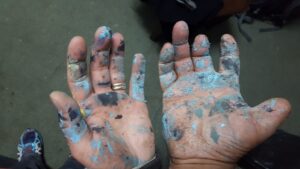
A.W: ALAS is interested in the practice of “psychogeography”, you used your walking tours as a means to spread knowledge, tell us about this.
S.L: I used my walking tours to spread knowledge and information about Palestine. This was a part of the hostel business, and the hostel became a hub of information for visitors. Information about me being able to give information and teach about Palestine passed through word of mouth. I had to stop the walking tours, due to health problems, caused by an injury obtained as a teenager by a bomb. The pain came back and I had to stop my walking tours, and they became tours using a car, all the way up until the war broke out. We had a big break during covid, which caused a recession with many things, and now due to the war on Gaza, tourism is dead in the West Bank. I was away from Palestine two months before the war started, and when it did, I was not able to go back. As I wasn’t able to return to Palestine, I became more active online so that I could spread the knowledge, information about what is going on and what is happening, which makes it more unsafe for me to go back, as Israel targets those who talk about Palestine and the genocide. Those who I know who were active in the field, and very vocal about what happened, have been kidnapped or killed. I am just a normal person, a normal Palestinian who refuses to stay silent on what is happening, and that makes me a target. Your silence cannot buy you safety, it may delay what is inevitable, but it doesn’t allow you to remain safe.
There is an entire disregard and dehumanisation of Palestinians, holding onto one, or a few stories is important. I encourage people to dig deep into these single stories of the Palestinian people and bring them back to life, they are not just numbers and statistics, but people who are living through something unimaginable. It is important to remember we aren’t just talking about 60, 70, 80 thousand people being slaughtered, but that many dreams that have been destroyed, that many hellos and goodbyes that we won’t hear again. These are the stories that need to be heard, and talked about. Humanisation is so important.
Throughout our conversation, Salah went on to share some personal stories of loved ones, friends and acquaintances who he has known, and lost during the war, as well as throughout his life. These are stories of much abhorrence and violent treatment that is incomprehensible.
It is of the most importance to keep sharing, acknowledging, and most importantly, listening to personal stories like Salah’s. The mural remains as relevant to today as it was when it was first created back in 2017.
During these times, we think of friends and colleagues facing turbulent times across the world.
“When art reaches two minds that are interested in creating peace, minds will make peace”.
